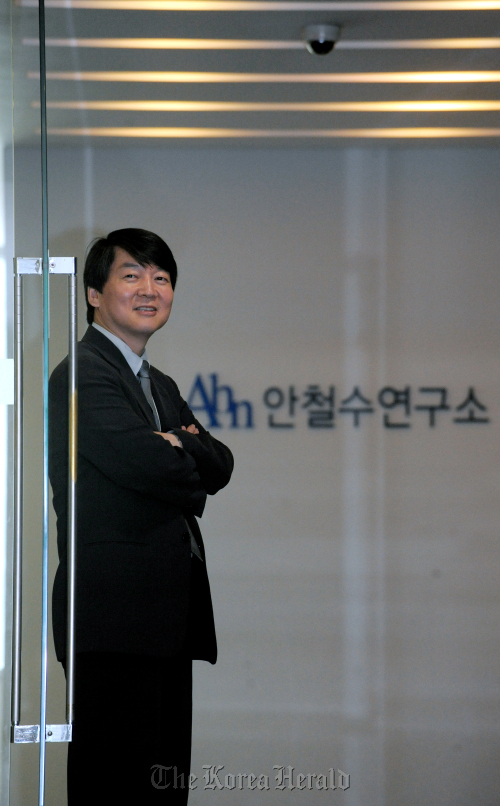
Ahn committed to planting entrepreneurship in young hopefuls
Behind Korea’s leadership in the high-tech world are a number of business innovators, technology wizards and far-sighted investors.
Ahn Cheol-soo leads the pack with his success, acumen and a dramatic life story that combined to make him a towering symbol of digital-era entrepreneurship.
He polled as the most respected role model among Korean youths, many of whom are inspired by his famous maxim: “Cells are in a state of stability only when they are dead.”
And change has marked his career for the past 20 years, from medical professor to software developer and executive to influential management guru.
Ahn, 49, is now taking on new challenges. He recently took the helm of a fledgling graduate school aiming to nurture interdisciplinary talents of science and technology.
Through lectures and writings, he has also become the most vocal critic of conglomerates’ dominant power that chokes innovation and new businesses.
In the eyes of the visionary business philosopher, Korea’s technology sector is on the verge of being reduced to a dead cell.
Venture businesses have lost their vigor under pressure from Samsung, LG, SK and other goliaths. High barriers among different fields retard technology development. No second chance is given when a business fails despite promising skills and ideas.
“The lopsided relationship between large companies and their smaller partners emasculates the country’s overall competitiveness,” said Ahn, who currently serves as dean of Graduate School of Convergence Science and Technology at Seoul National University.
“We need a sound ecosystem to help venture firms and small- and medium-sized businesses transform from ‘fast followers,’ into ‘first movers.’”
He estimated that 90 percent of innovative ideas come from SMEs and startups and less than 10 percent from large companies. Cooperation with the smaller players is essential for the survival of large corporations.
“The lost three years” is a term coined by Ahn to refer to Korea’s sluggish progress on the global information technology landscape. Despite market hits like Samsung’s Galaxy S, the software sector here has stagnated in recent years.
“There are no promising ventures in the industry,” Ahn told The Korea Herald. “If not now, there will be none in 10 years either. We need soil in which young shoots can bud, so ordinary people will start up their own enterprises.”
Ahn spoke from the office of AhnLab, Korea’s top antivirus software and security solutions developer. He founded the company in 1995 and now serves as chairman of the board.
In the early 1990s, Ahn was a promising medical science professor. But his interest and expertise in computers led him to walk out of the secure, high-income profession and chart a new career as a venture businessman.
In 2005, he resigned as chief executive officer of AhnLab to study business management in the U.S. He obtained an MBA from Wharton School of the University of Pennsylvania and returned to Korea in May 2008. Then he taught entrepreneurship as a distinguished professor at Korea Advanced Institute of Science and Technology.
In June, he became chief of the two-year-old convergence studies school of his alma mater SNU. The institute located in Suwon, Gyeonggi Province, consists of four departments -- nano science and technology, digital contents convergence, intelligence convergence system and molecular medicine and biopharmaceutical sciences.
“Convergence is the sequence of attempts to get back to our natural state,” Ahn said.
“Nature has not just one aspect but multiple by origin. It’s artificially sorted out into psychology, sociology, engineering and others by human beings, who had found society and natural phenomena too difficult to understand. But you can’t draw a line between them -- you should see the whole picture. So the existing classification method has reached the end of its tether.”
At the school, he aims to imbue young talent with entrepreneurship by creating links between technology and practical applications.
“Koreans have more entrepreneurial flair (than people in other countries that have produced successful startups). But the current social structure does not give a second or third chance to those who failed once, repressing their business minds,” Ahn said.
There are more losers than winners in Silicon Valley, Ahn said, but many of them take on another experiment soon after, without being branded as a “failure.”
“Once they have failed, they don’t make the same mistake the second time around. Giving another chance to ‘faithful failures’ makes a big difference,” Ahn said.
Responding to those who criticized his moving to the country’s top university, Ahn called the new job “far more challenging.”
“At KAIST, I had a good, easy job unless I went on a lecture tour,” he said. “I taught around 100 students per semester and that was it. But my duty was confined to teaching, so my opinions were not reflected in administrative affairs whatsoever.”
The new job is rejuvenating Ahn’s venture spirit.
“I believe I can contribute more by improving the entire graduate school,” Ahn went on. “Yes, there are things to fix here, like those related to the location and central and local governments. But that’s what makes this job more doable.”
By Shin Hyon-hee (heeshin@heraldcorp.com)



















![[Today’s K-pop] BTS pop-up event to come to Seoul](http://res.heraldm.com/phpwas/restmb_idxmake.php?idx=642&simg=/content/image/2024/04/17/20240417050734_0.jpg&u=)